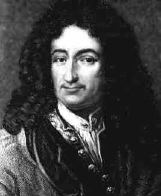

Gottfried Leibniz's father died when Leibniz was only 6, and he was brought up by his mother, from whom he learned his moral and religious values. In school, he taught himself advanced Latin and Greek, and read Aristotle and many metaphysics and theology books. At the age of 14, he entered the University of Leipzig to study philosophy and mathematics. A few days after Leibniz was awarded his Master's Degree in philosophy, his mother died.
After being awarded a bachelor's degree in law, Leibniz worked on his habilitation in philosophy. In this work, published in 1666, Leibniz aimed to reduce all reasoning and discovery to a combination of basic elements such as numbers, letters, sounds and colours.
Despite his growing reputation and acknowledged scholarship, Leibniz was refused the doctorate in law at Leipzig. He went immediately to the University of Altdorf where he received a doctorate in law in 1667.
During the next few years Leibniz undertook a variety of different projects, scientific, literary and political. He also continued his law career taking up residence at the courts
of Mainz before 1670.
One of Leibniz's lifelong aims was to collate all human knowledge. As part
of this scheme, Leibniz tried to bring the work of the learned societies together to coordinate research. Leibniz put much energy into promoting scientific societies. Later in life, he was involved in moves to set up academies in Berlin, Dresden, Vienna, and St. Petersburg.
Leibniz began to study motion, and although he had in
mind the problem of explaining the results of Wren and Huygens on elastic collisions, he began with abstract ideas of motion. In 1671 he published a work in which he claims that movement depends on the action of a spirit. Another important piece of mathematical work undertaken by Leibniz was his work on dynamics. He criticized Descartes' ideas of mechanics and examined what
are effectively kinetic energy, potential energy and momentum.
The Royal Society of London elected Leibniz a fellow in 1673. He studied mathematics and physics under Huygens, and read works by Pascal, Fabri, Gregory, Saint-Vincent, Descartes and Sluze. He began to study the geometry of infinitesimals.
It was during this period in Paris that Leibniz developed the basic features of his version of the calculus. In 1673, he was still struggling to develop a good
notation for his calculus and his first calculations were clumsy. In 1675, he wrote a manuscript using the integral notation for the first time. In the
same manuscript the product rule for differentiation is given. By 1676 Leibniz had discovered the familiar power rule for both integral and fractional exponents.
The rest of Leibniz's life was spent at Hanover except for the many travels that he made.
Leibniz achieved important scientific results becoming one of the first people to study geology.
Another of Leibniz's great achievements in mathematics was his development of the binary system of arithmetic. He perfected his system by 1679 but he did not publish anything until 1701. Another major mathematical work by Leibniz was his work on determinants which arose from his developing methods to solve systems of linear equations.
Although he never published this work in his lifetime, he developed many different approaches to the topic with many different notations being tried out to find
the one which was most useful.
Leibniz continued to perfect his metaphysical system in the 1680's attempting to reduce reasoning to an algebra of thought.
In 1684 Leibniz published details of his differential calculus. The paper contained the familiar differential notation, the rules for computing the derivatives of powers, products and quotients.
However it contained no proofs, and Jacob Bernoulli called it an enigma rather than an explanation.
In 1686, Leibniz published a paper dealing with the integral calculus with the first appearance in print of the integral notation.
Newton's Principia appeared the following year. Newton's "method of fluxions" was written in 1671, but Newton failed to get it published and it did not appear
in print until John Colson produced an English translation in 1736. This time delay in the publication of Newton's work resulted in a dispute with Leibniz.
It is no exaggeration to say that Leibniz corresponded with most of the scholars in Europe. He had over 600 correspondents. Among his correspondence were discussions of paradoxes like putting x=1 into 1/(1+x) = 1 – x + x2 – x3.... and taking the logarithms of negative numbers.
In 1710, Leibniz published a philosophical work intended to tackle the problem of evil in a world created by a good God. Leibniz claims that the
universe had to be imperfect, otherwise it would not be distinct from God. He then claims that the universe is the best possible without being perfect.
Much of the mathematical activity of Leibniz's last years involved the priority dispute over the invention of the calculus. The Royal Society set up a
committee to pronounce on the priority dispute. It was totally biased, not asking Leibniz to give his version of the events. The report of the committee, finding in
favor of Newton, was written by Newton himself. Leibniz spent years afterward trying to tell his side of the story.